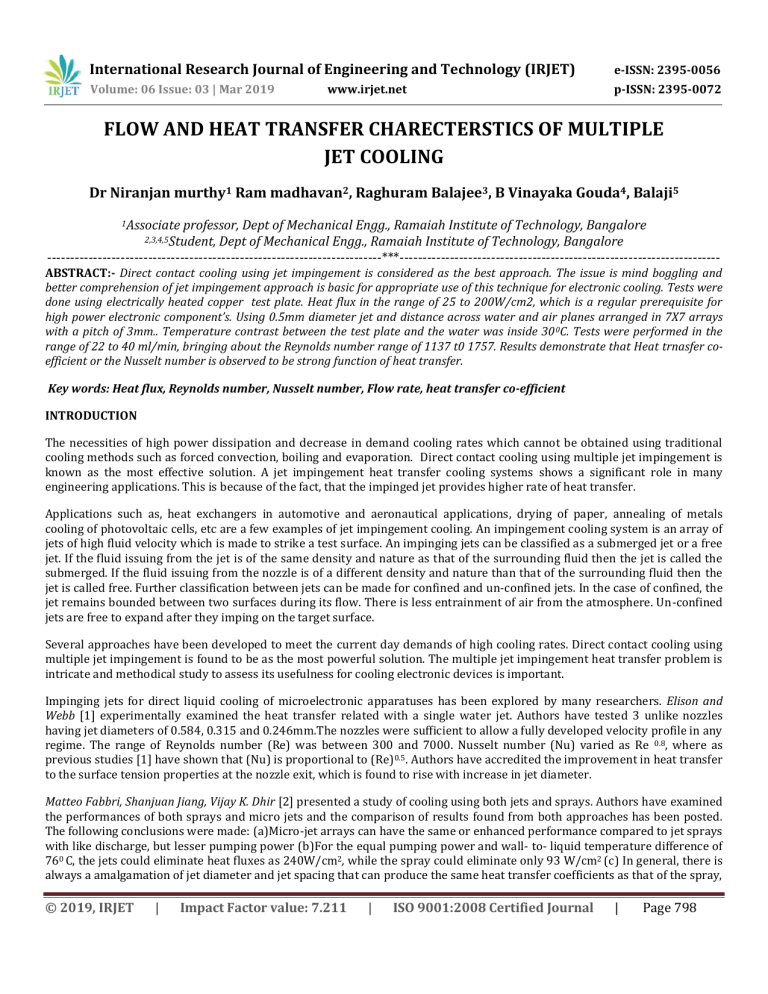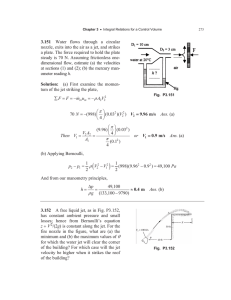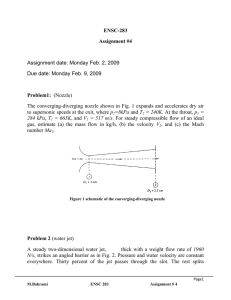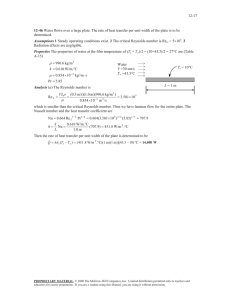IRJET-Flow and Heat Transfer Charecterstics of Multiple Jet Cooling
advertisement

International Research Journal of Engineering and Technology (IRJET) e-ISSN: 2395-0056 Volume: 06 Issue: 03 | Mar 2019 p-ISSN: 2395-0072 www.irjet.net FLOW AND HEAT TRANSFER CHARECTERSTICS OF MULTIPLE JET COOLING Dr Niranjan murthy1 Ram madhavan2, Raghuram Balajee3, B Vinayaka Gouda4, Balaji5 1Associate professor, Dept of Mechanical Engg., Ramaiah Institute of Technology, Bangalore Dept of Mechanical Engg., Ramaiah Institute of Technology, Bangalore -------------------------------------------------------------------------***---------------------------------------------------------------------2,3,4,5Student, ABSTRACT:- Direct contact cooling using jet impingement is considered as the best approach. The issue is mind boggling and better comprehension of jet impingement approach is basic for appropriate use of this technique for electronic cooling. Tests were done using electrically heated copper test plate. Heat flux in the range of 25 to 200W/cm2, which is a regular prerequisite for high power electronic component’s. Using 0.5mm diameter jet and distance across water and air planes arranged in 7X7 arrays with a pitch of 3mm.. Temperature contrast between the test plate and the water was inside 30 0C. Tests were performed in the range of 22 to 40 ml/min, bringing about the Reynolds number range of 1137 t0 1757. Results demonstrate that Heat trnasfer coefficient or the Nusselt number is observed to be strong function of heat transfer. Key words: Heat flux, Reynolds number, Nusselt number, Flow rate, heat transfer co-efficient INTRODUCTION The necessities of high power dissipation and decrease in demand cooling rates which cannot be obtained using traditional cooling methods such as forced convection, boiling and evaporation. Direct contact cooling using multiple jet impingement is known as the most effective solution. A jet impingement heat transfer cooling systems shows a significant role in many engineering applications. This is because of the fact, that the impinged jet provides higher rate of heat transfer. Applications such as, heat exchangers in automotive and aeronautical applications, drying of paper, annealing of metals cooling of photovoltaic cells, etc are a few examples of jet impingement cooling. An impingement cooling system is an array of jets of high fluid velocity which is made to strike a test surface. An impinging jets can be classified as a submerged jet or a free jet. If the fluid issuing from the jet is of the same density and nature as that of the surrounding fluid then the jet is called the submerged. If the fluid issuing from the nozzle is of a different density and nature than that of the surrounding fluid then the jet is called free. Further classification between jets can be made for confined and un-confined jets. In the case of confined, the jet remains bounded between two surfaces during its flow. There is less entrainment of air from the atmosphere. Un-confined jets are free to expand after they imping on the target surface. Several approaches have been developed to meet the current day demands of high cooling rates. Direct contact cooling using multiple jet impingement is found to be as the most powerful solution. The multiple jet impingement heat transfer problem is intricate and methodical study to assess its usefulness for cooling electronic devices is important. Impinging jets for direct liquid cooling of microelectronic apparatuses has been explored by many researchers. Elison and Webb [1] experimentally examined the heat transfer related with a single water jet. Authors have tested 3 unlike nozzles having jet diameters of 0.584, 0.315 and 0.246mm.The nozzles were sufficient to allow a fully developed velocity profile in any regime. The range of Reynolds number (Re) was between 300 and 7000. Nusselt number (Nu) varied as Re 0.8, where as previous studies [1] have shown that (Nu) is proportional to (Re) 0.5. Authors have accredited the improvement in heat transfer to the surface tension properties at the nozzle exit, which is found to rise with increase in jet diameter. Matteo Fabbri, Shanjuan Jiang, Vijay K. Dhir [2] presented a study of cooling using both jets and sprays. Authors have examined the performances of both sprays and micro jets and the comparison of results found from both approaches has been posted. The following conclusions were made: (a)Micro-jet arrays can have the same or enhanced performance compared to jet sprays with like discharge, but lesser pumping power (b)For the equal pumping power and wall- to- liquid temperature difference of 760 C, the jets could eliminate heat fluxes as 240W/cm2, while the spray could eliminate only 93 W/cm2 (c) In general, there is always a amalgamation of jet diameter and jet spacing that can produce the same heat transfer coefficients as that of the spray, © 2019, IRJET | Impact Factor value: 7.211 | ISO 9001:2008 Certified Journal | Page 798 International Research Journal of Engineering and Technology (IRJET) e-ISSN: 2395-0056 Volume: 06 Issue: 03 | Mar 2019 p-ISSN: 2395-0072 www.irjet.net but at much lesser pumping power costs and (d)A very occupied micro jet arrays were much more superior than the arrays with limited and more jets, because they needed a much lesser discahrge to obtain the same heat removal rate. Jiji and Dagan [3] observed the heat transfer related with several single phase free surface jets impinging on an array of microelectronic heat sources. They used square arrays of 1, 4 and 9 jets using FC 77 as the fluids on multiple heat sources of size 12.7 x 12.7 mm2 and observed that the surface temperature consistency enhanced as the spacing between the jets reduced. It was also detected that multiple jets impinging on a heater surface can recover the spatial consistency of the heat transfer coefficient on the surface. Womac et al [4] conducted tests with 2x2 and 3x3 jet arrays using water and FC77. The test surface made of copper was a 12.7x12.7 mm2. Experiments were done with jet diameters of 0.513 and 1.02 mm and pitches of 5.08 and 10.16 mm. It was concluded that for a given discharge, the heat transfer enhanced with the higher jet velocities. It was also found that the decrease in heat transfer that arises with reducing the discharge develops more noticeable at very low discharge rates and authors have accredited this effect is due to the majority heating of the fluid. Wang et al. [5] conducted with a micro-jet heat sinks to cool VLSI chips. Micro-jet heat sinks can increase temperature consistency in the existence of chip hotspots. Experimental evaluation of micro-jet and micro-channel presentation exhibited that micro-jets have enhanced thermal consistency; The results recommended that micro-jet arrays are the favored micro heat sinks for active device cooling. Matteo Fabbri, Shanjuan Jiang, Vijay K. Dhir [6] conducted a circular arrays of free surface micro jets. Tests were done by using jet pitches of 1, 2 and 3mm and jet diameters of 50, 100,150 and 250µm. De-ionised water and FC40 was used for cooling. . The Prandtl number was varied from 6 to 84 jet Reynolds number was varied between 90 and 2000. Heat flux up to 250 W/cm2 could be detached with water. Authors have found that Nusselt number is highly reliant on on the Reynolds number. NOMENCLATURE A Hot plate surface area (cm2) d Nozzle diameter (mm) h Heat transfer coefficient (W/cm2c) ( q / (Tc -Tw) ) Nu Nusselt number ( hd/k) P Total heat transfer (W) q Heat flux (W/cm2) (P/A ) Q Total flow rate (ml/min) Re Reynolds number (Vd/ν) Tb Bulk fluid temperature (0C) Tc Chip surface temperature (0C) Tw Inlet water temperature (0C) V Jet velocity (m/s) ν Kinematic viscosity (Ns/m2) z Nozzle height from chip surface (mm) ∆T Chip surface temperature - Inlet water temperature (0C) © 2019, IRJET | Impact Factor value: 7.211 | ISO 9001:2008 Certified Journal | Page 799 International Research Journal of Engineering and Technology (IRJET) e-ISSN: 2395-0056 Volume: 06 Issue: 03 | Mar 2019 p-ISSN: 2395-0072 www.irjet.net Experimental apparatus and procedures The test apparatus is shown schematically as shown in Fig. 1. The test setup is designed and made-up to carry out tests using different types of nozzles containing the jets. It consists of fluid delivery air compressor, system, heater assembly, jet nozzle head and test stand. The fluid distribution system contains of a water tank, auxiliary tank, discharge control valves, pressure device, filter and piping systems. The auxiliary reservoir is a steel vessel designed to withstand 10 bar. The auxiliary tank acts as a cushion, smooth out flow variations and gives constant flow to the nozzle head. It also serves to achieve fine control over the flow rate by adjusting pressure. Safety valve is provided to prevent excess pressure build-up. The heater unit contains of test plate, heating element, thermocouples, varying transformer and a control - unit. The test plate signifies the surface of an electronic chip and is made of Copper. Copper is choosen because of its great thermal conductivity. The hot plate is of 2cm x 2cm size and thickness 1mm. The hot plate was mounted on the heating element.. The heat to the heater was varied using the varying transformer. 2 thermocouples were placed under the test plate on the centre line and insulated with insulation. The nozzle plate is made of 3mm thick stainless steel plate. The nozzle plate was considered to cover the nozzle chamber making it a single unit. The nozzle plate had 49 holes, each of 0.5 mm diameter, which are laser holes and arranged in a square array of 7X7 with a pitch distance of 3mm between the holes. The distance between the nozzle plate and the test plate surface can be varied. The flow rate, power input and distance between nozzle exit and test hot plate were varied during the experiments. The hot plate is allowed to reach steady state before gaining of test data on water flow rate, power dissipation and temperatures from thermocouples. Fig 1 Schematic diagram of experimental set up RESULTS AND DISCUSSIONS Fig 2 shows the variation of heat transfer co-efficient plotted against the temperature difference among the test plate and water at inlet (∆t 0C) for different flow rates for d=0.5mm and jet exit to test plate surface distances (Z). For a given value of (∆t), the heat transfer co-efficient increases with the increase in flow rate. It should be noted that the heat flux is also increasing with the variation of flow rate at the constant temperature difference (∆t). © 2019, IRJET | Impact Factor value: 7.211 | ISO 9001:2008 Certified Journal | Page 800 International Research Journal of Engineering and Technology (IRJET) e-ISSN: 2395-0056 Volume: 06 Issue: 03 | Mar 2019 p-ISSN: 2395-0072 www.irjet.net Flow rate (ml/min) 1320 1440 1560 1740 2040 10 9 8 C 7 2 0 6 h W/cm 5 4 3 2 1 0 12 14 16 18 20 22 24 26 28 t C 0 Fig2: Variation of heat transfer co-efficient with temperature difference for different flow rates at Z=20mm and d=0.50mm for vertical jets 25 Heat flux W/cm2 100 200 10 havg W/cm2 0C 9 8 7 6 5 4 3 2 1 0 1200 1400 1600 1800 2000 2200 Flow rate (ml/min) Fig3:Variation of heat transfer co-efficient with flow rates for different heat fluxes at Z=20mm and d=0.50mm for vertical jets Figs3 show the effect of flow rate on heat transfer coefficient at constant heat flux.Results are presented for different values of heat flux. Heat transfer coefficient increases with increase in flow rate which is due to the effect of forced convection. As the flow rate increases, it causes more turbulence in the impingement zone which enhances the heat transfer coefficient. © 2019, IRJET | Impact Factor value: 7.211 | ISO 9001:2008 Certified Journal | Page 801 International Research Journal of Engineering and Technology (IRJET) e-ISSN: 2395-0056 Volume: 06 Issue: 03 | Mar 2019 p-ISSN: 2395-0072 www.irjet.net Average Nusselt number Fig4 shows Variation of Nusselt number with Reynolds number for different heat fluxes .The (Nu) versus (Re) variations are shifted upwards as heat flux is increased in the range of 25 to 200 W/cm 2. These results indicate that the Nusselt number is a very strong function of heat flux; Nusselt number increases significantly with increase in heat flux. As the heat flux is increased, larger effect of the jet diameter on the (Nu) versus (Re) variation can be noticed. The (Nu) versus (Re) variation is not continuous at higher values of heat flux, because of the change in jet diameter. d=0.25 (25) d=0.25 (50) d=0.25 (100) d=0.25 (150) d=0.25 (200) d=0.50 (25) d=0.50 (50) d=0.50 (100) d=0.50 (150) d=0.50 (200) 80 70 60 50 40 30 20 10 0 1000 1200 1400 1600 1800 2000 2200 2400 Reynolds number Fig 4: Variation of Nusselt number with Reynolds number for different heat fluxes at Z=20mm for vertical jets, numbers within brackets indicates heat flux in W/cm2 Fig 5 show the variation of heat transfer coefficient as a function of temperature difference between the air at inlet (Δt) and test surface. The Reynolds number (Re) based on jet diameter and jet exit-to-test plate surface distances (Z) were varied. Results have been plotted for the jet diameter of 0.5mm. For a given value of (Δt), the heat transfer coefficient increases with increase in Reynolds number number. Fig 6 show the variation of Nusselt number with Reynolds number for the heat flux range of 25 to 200 W/cm2 for d=0.5mm, Z= 20mm for vertical positioning of the jets. As the heat flux is increased in the range of 25 to 200 W/cm2, the plots of Nusselt number versus Reynolds number shift upwards. Although, slight variation with the Reynolds number has been noticed, the Nusselt number is found to be a strong function of heat flux. This is due to the thinning of the boundary layer surface and increased turbulence in the wall region. © 2019, IRJET | Impact Factor value: 7.211 | ISO 9001:2008 Certified Journal | Page 802 International Research Journal of Engineering and Technology (IRJET) e-ISSN: 2395-0056 Volume: 06 Issue: 03 | Mar 2019 p-ISSN: 2395-0072 www.irjet.net Re 1290 Re 1570 Re 1816 5 4 3 2 0C havg W/cm2 0C 6 1 0 50 60 70 t C 0 80 Fig 5: Variation of heat transfer co-efficient with temperature difference for different flow rates at Z=20mm and d=0.50mm for vertical jets Average Nusselt number Heat flux W/cm2 25 50 100 150 200 800 700 600 500 400 300 200 100 0 1000 1200 1400 1600 1800 2000 Reynolds number Fig 6: Variation of Nusselt number with Reynolds number for different heat fluxes at Z=20mm and d=0.50mm for vertical jets © 2019, IRJET | Impact Factor value: 7.211 | ISO 9001:2008 Certified Journal | Page 803 International Research Journal of Engineering and Technology (IRJET) e-ISSN: 2395-0056 Volume: 06 Issue: 03 | Mar 2019 p-ISSN: 2395-0072 www.irjet.net CONCLUSION Experiments were conducted to study the enhancement of heat transfer using impingement of multiple water jets on a electrically heated test plate. Heat flux in the range of 25 to 200W/cm 2 which is distinctive for high power electronic devices was dissipated using multiple water and air jets of 0.5mm diameter the temperature difference between the test plate and water is within 300c.Tests were conducted by varying the heat flux, flow rate, the distance between the heated test plate and the nozzle exit and the horizontal and vertical positioning of the jets and the test plate. It is observed that the heat transfer coefficient is a strong function of heat flux, the effect of Reynolds number is found to be small. The effect of (i) Distance between the heated test plate and the nozzle exit and (ii) Horizontal or vertical positioning of the jets and the test plates is found to be negligible. REFERENCES [1] Elison, B.and Webb, B.W., 1994 “ local heat transfer to impinging liquid jets in the initially laminar, transitional, and turbulent regimes.”international journal of heat and mass transfer, 37, no 8, pp.1207-1216. [2] Matteo Fabbri, Shanjuan Jiang, Vijay K. Dhir; Comparative Study of Spray and Multiple Micro Jets Cooling for High Power Density Electronic Applications (Nov 2003) [3] Jiji.L.J and Dagan.Z; Experimental Investigation of Single-Phase Multi Jet Impingement Cooling of an Array of Micro Electronic Heat Sources (1987); Proceedings of the International Symposium on Cooling Technology for Electronic Equipment, W. Aung, ed., Hemisphere Publishing Corporation, Washington.D.C., pp. 333–351. [4] Womac.D. J, Incropera.F. P and Ramadhyani.S; Correlating Equations for Impingement Cooling of Small Heat Sources With Multiple Circular Liquid Jets (1994); ASME J. Heat Transfer, 116, pp. 482–486. [5] Wang.E.N, Zhang.L, Jiang.L, Koo.J.M, Goodson.K. E, Kenny.T.W, Maveety.J. G, Sanchez.E.A; Micro-machined Jet Arrays for Liquid Impingement Cooling of VLSI Chips, Solid-State Sensor, Actuator and Microsystems Workshop; Hilton Head Island, South Carolina, June 2-6, 2002. [6] Matteo Fabbri, Shanjuan Jiang, Vijay K. Dhir; “Experimental investigation of single – phase micro jets impingement cooling for electronic applications” 2003 ASME Summer Heat Transfer Conference July 21-23, Las Vegas, Nevada, USA [7] Yang Cheng, Andrew A.O. Tay, Xue Hong “ An experimental study of liquid jet impingement cooling of electronic components with and without boiling” 2001 International symposium on electronic materials and packaging. [8] Lin Z.H., Chou Y.J., and Hung, Y.H. (1997). Heat transfer behaviors of a confined slot jet impingement, International Journal of Heat and M ass Transfer, Vol.40, pp. 1095-1107. [9] A.G.Pautsch, T.A.Shedd - University of Wisconsin – Madison, USA; Spray Impingement Cooling with Single and Multiple Nozzle Arrays (2005). [10] 3M specialty fluids (2006); http://3m.com/market/industrial/fluid/library. © 2019, IRJET | Impact Factor value: 7.211 | ISO 9001:2008 Certified Journal | Page 804



